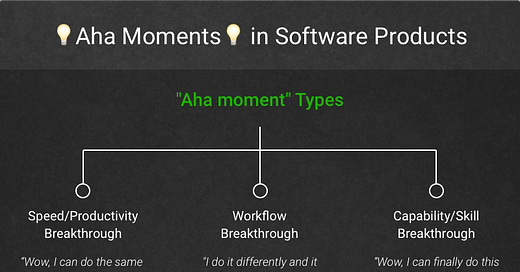Founder Memo: 💡 Aha Moments💡 in Software Product
How not to confuse "ahahaha moments" with "aha moments"
Hi, I’m Clement. The Big Picture is a newsletter for founders and investors who want to make sense of what is happening in the SaaS industry.
You can find me in the Dungeon:
This week’s post is mostly for founders.
Over the past couple of weeks, I’ve been working with two different startups on their product, and a common theme was their “aha moment.”
Below is a memo where I sum up what I’ve learned and observed about aha moments in B2B software products.
Definition of Aha Moment:The “aha moment” is the moment when a user realizes the value that a software product can bring them.
The Three Types of Product “Aha Moment”
First of all, I’ve noticed that, conceptually, there aren’t that many different types of aha moments in software products.
There are many variations, but imo they all revolve around three main types of aha moments:
1. Speed/productivity breakthrough
User realization: “wow, I can do the same thing, way faster.”
Description: The product delivers a significant speed or efficiency gain on tasks users already do and were very often done manually or through old school software.
Examples:
Editing text/code in VSCode instead of older IDEs.
Scheduling meetings with Calendly instead of back-and-forth emails.
Superhuman's email triage feature.
Effect: Feels like a productivity boost: Same (or better) output, but in less time.
2. Workflow breakthrough
User realization: “I do it differently and it feels way better.”
Description: The product replaces an entire approach or mental model with something smoother or more intuitive.
Examples:
Using ChatGPT instead of Googling → answer directly, not searching through tens of results and scrolling cluttered pages (for me personally ChatGPT really changed how I search the web which is a daily task).
Grammarly for instant correction (I still remember when I had to copy/paste text in Google Docs to spell check it).
Many vertical SaaS that replace paper and manual processes with a digital solution.
Effect: Feels like a shift in how you think or work, with a new default behavior that reduces your mental load.
3. Capability/skill breakthrough
User realization: “Wow, I can finally do this myself.”
Description: The product unlocks access to something previously too hard, technical, or expensive to do for the user.
Examples:
Stripe enabling anyone to take payments online (it was really a huge shift back then compared to bank solutions).
Zapier letting non-coders automate workflows between apps.
Lovable making it possible for everyone to design landing pages just with text prompts.
Effect: Feels like empowerment, like crossing a capability boundary.
Are Aha Moments Compulsory to Succeed and Grow Revenue?
Absolutely not. Aha moments are not a requirement for success nor a guarantee.
Most enterprise products win on sales and politics rather than on product aha moments. When you’re selling complex software with big budgets, significant implementation, and extensive change management, it’s not unusual for there to be no clear aha moment for users.
You can win on price instead of product. Some products do the same thing as their competitors without delivering a strong aha moment. But they win simply by being cheaper. This is especially true in commoditized software spaces, where price dominates buying decisions.
You can win with strong branding and trust. Some B2B startups succeed not because their product is the best, but because their brand is well recognized and trusted.
In underserved categories with few choices, you can win with a messy product. Sometimes there’s a lack of competition or alternative solutions and you can win simply by being there.
Product aha moments are less strong in replacement markets vs in equipment markets. I’ve seen many cases where a better product fails because the market is predominantly a replacement market. In those cases, product quality is not the main driver of a purchasing decision: Familiarity, relationships, branding, budget cycles and pricing carry much more weight.
Aha moments aren’t the end game. The real value of a product can come later through depth, retention, and loyalty. You can have a strong aha moment but still a shallow or buggy product which may undermine its long-term success.
How to Know If You Have an Aha Moment in Your Product?
First of all, you need to distinguish direct aha moments from compounding aha moments:
Direct aha moment: When it’s clear in your product when a user realizes its value. Usually, this happens fairly quickly through well-defined features.
Compounding aha moment: When the value realization emerges after a series of steps. Some aha moments take more time to arrive because you need to set up the product, import data, create new habits, or go up a learning curve. For instance, this is often the case with VSaaS products, where several steps are required before the real value is perceptible.
Knowing that, here’s a list of questions to help you determine whether you already have an aha moment in your product and, if not, where you should be looking:
Can you clearly and concretely identify the pain or task that your aha moment should solve?
Using your product, is there a clear contrast between the “old way” and your new way for the user?
Have you noticed your product triggering an emotional reaction in users? (In product demos, sales calls, spontaneous emails, social media messages, strong organic word of mouth, etc.).
In the case of a straightforward aha moment: Is it clear which feature, process, or outcome is triggering this emotional response?
In the case of a compounding aha moment: Is it clear which steps or prerequisites need to be in place before your product delivers that moment of realization?
Aha Moment Metrics
In my opinion, there are three main metrics you should put in place when it comes to product aha moments:
Measure whether a user reaches the aha moment or not. The first step is to track whether or not a user reaches your aha moment. It can be hard to put an exact metric on it, so it’s ok to use proxy metrics.
Measure the percentage of users who reach it. Once you know whether a user reaches the aha moment, it’s helpful to track the percentage of new users who do.
Evaluate the time it takes to reach it. Finally, try to measure how long it typically takes for a user to reach the aha moment. This can help you gauge whether there’s too much friction or complexity in your onboarding or product flow.
Common Aha Moment Traps
Here are a couple of common traps related to product aha moments:
The aha moment is too deep in the product. Usually this happens when there are too many unnecessary steps before the aha moment, or when it’s buried under a pile of nice-to-have features.
Too much friction to reach the aha moment. Sometimes the path to the aha moment is too difficult. For instance when you require users to import data, invite colleagues, go through a heavy setup process etc.
There’s no clear aha moment. This is typically the case for “good enough” products, where the product is fine but isn’t designed to provide a strong moment of realization.
No comparative aha moment. You can have a good product, but if the majority of your users are already using alternatives that are great or “good enough”, they won’t experience a strong aha moment with your product because they’ve already had that moment elsewhere. However, users who haven’t used those alternatives might still experience it when they try your product for the first time.
Aha Moments in LLM-Powered B2B Software
Here are some observations I’ve made about aha moments in AI-powered B2B software:
Most AI agents are a single-user experience. They’re designed to deliver immediate value to an individual without requiring collaboration or multiple users.
Setup and data import can create friction in reaching the aha moment. Getting your data into the product or integrating it with your existing stack are often a hurdle.
AI hallucinations or unreliable output can undermine the aha moment. When LLMs produce confusing, invalid, or false information, it erodes trust and dampens the moment of realization.
The most powerful aha moments enable a radical change in the way a person works. This is true across the three main breakthrough types: speed, workflow, and skill.
Sustained value after the aha moment is not automatic. One big hurdle for many AI products is turning that initial aha moment into long term value. Paradoxically it’s easier to design an aha moment with a LLM powered software but harder to create long term value.
As usual happy to read your comments or messages.





